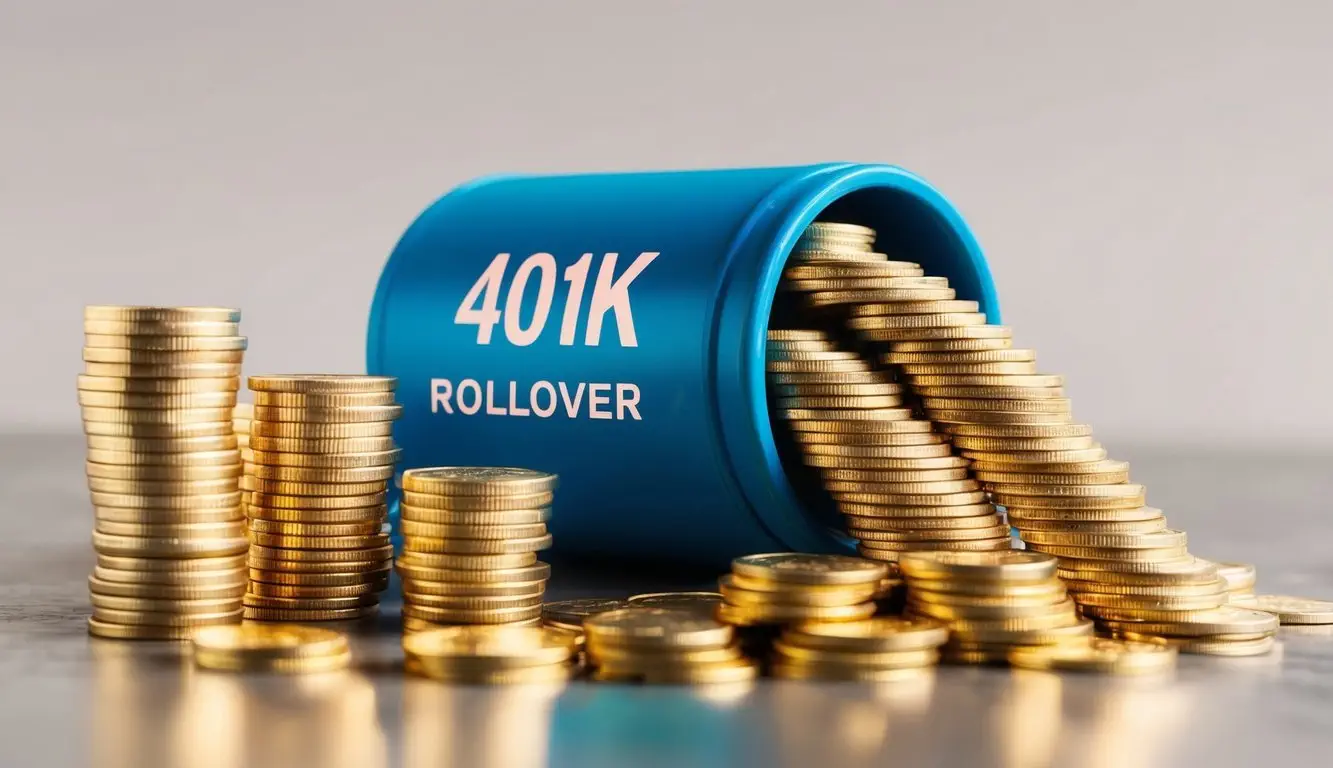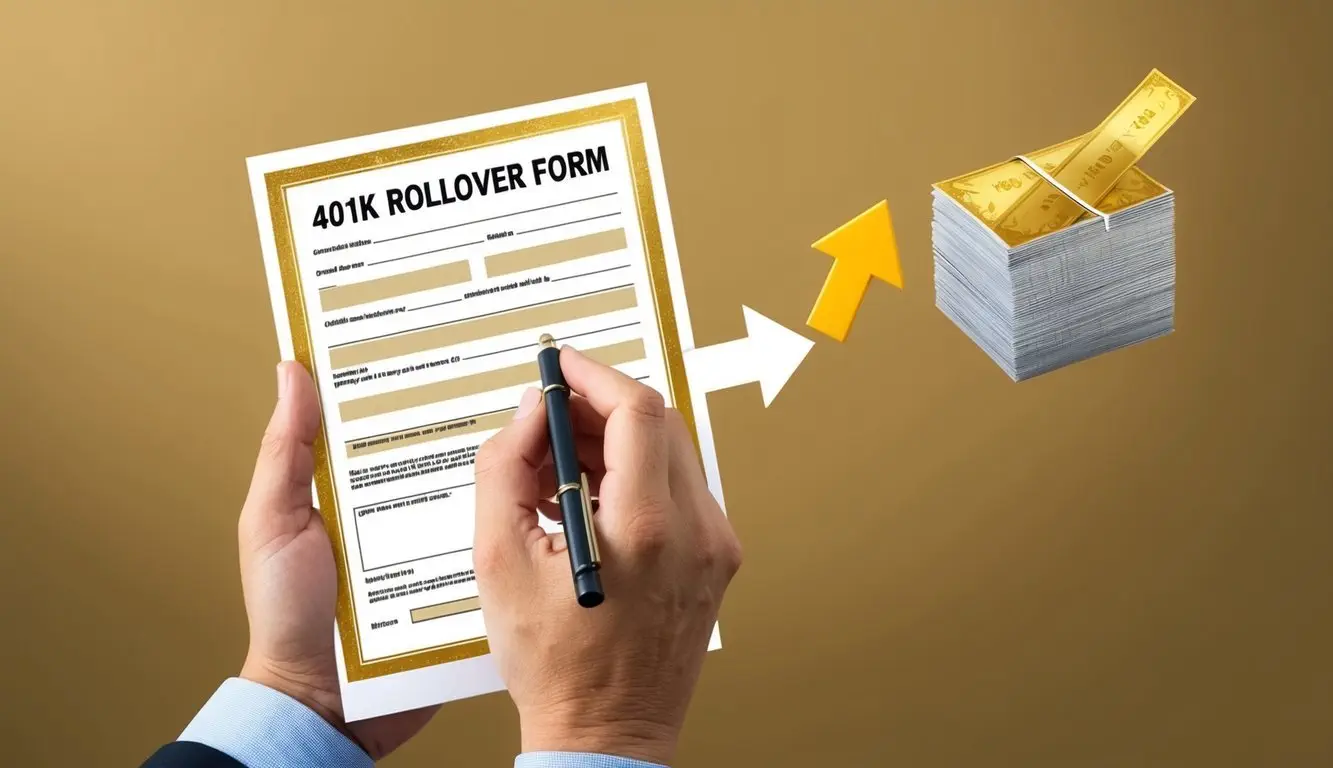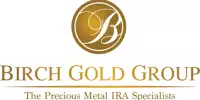Thinking about your retirement savings? A 401k rollover to gold might be worth considering in today’s economic climate. This option allows investors to transfer funds from their employer-sponsored retirement plan into a gold-backed IRA without facing immediate tax penalties.

Converting your 401k into gold assets through a proper rollover can help protect your retirement savings from inflation and market volatility. The process involves working with a custodian who specializes in precious metals IRAs and follows IRS regulations to ensure compliance.
Gold IRAs have become increasingly popular among retirees and those approaching retirement age. They offer diversification beyond traditional stocks and bonds while potentially preserving wealth during economic uncertainty. The rollover process typically requires minimal paperwork but careful attention to timing rules.
Understanding 401(k) and Gold IRA Rollover Basics

Transferring retirement funds requires understanding key account types and processes. These options help investors diversify their portfolios while maintaining tax advantages designed for retirement savings.
The Concept of a 401(k) Rollover
A 401(k) rollover occurs when you move funds from an employer-sponsored retirement plan to another qualified retirement account. This typically happens when changing jobs, retiring, or seeking different investment options.
There are two main types of rollovers:
- Direct rollover: Funds transfer directly between accounts without passing through your hands
- Indirect rollover: Funds are distributed to you first, requiring deposit into a new account within 60 days to avoid taxes and penalties
Rollovers can involve various retirement accounts, including 401(k)s, 403(b)s, Thrift Savings Plans (TSP), SIMPLE IRAs, and SEP IRAs. Each type maintains specific rules but generally preserves tax-deferred status.
The IRS allows these transfers without immediate tax consequences when done correctly. This provides flexibility while keeping retirement savings intact.
Gold IRA Explained
A Gold IRA is a self-directed Individual Retirement Account that holds physical precious metals instead of paper assets. It functions under the same tax rules as traditional IRAs but contains gold, silver, platinum, or palladium.
Key facts about Gold IRAs:
- Requires a specialized custodian who handles IRS-approved precious metals
- Metals must meet minimum purity requirements (99.5% for gold)
- Assets must be stored in an IRS-approved depository, not personally held
Gold IRAs appeal to investors seeking:
- Portfolio diversification
- Inflation protection
- Reduced exposure to stock market volatility
The 401(k) to Gold IRA rollover process involves transferring funds from your employer plan to a self-directed IRA specifically set up to hold precious metals. This conversion maintains the tax-advantaged status of retirement funds.
Differences Between Traditional and Roth IRA
Traditional and Roth IRAs differ primarily in their tax treatment and withdrawal rules. These differences significantly impact rollover decisions and long-term financial planning.
Traditional IRA:
- Contributions may be tax-deductible in the year made
- Taxes are paid upon withdrawal during retirement
- Required Minimum Distributions (RMDs) begin at age 72
- Early withdrawals before age 59½ typically incur a 10% penalty
Roth IRA:
- Contributions are made with after-tax dollars
- Qualified withdrawals in retirement are tax-free
- No Required Minimum Distributions during the owner’s lifetime
- Original contributions can be withdrawn penalty-free anytime
Both account types can hold gold and other precious metals through a proper rollover. The choice between them depends on your current tax situation and retirement expectations.
Benefits of a Gold IRA Rollover

Converting your retirement savings to include precious metals offers several advantages in today’s economic environment. Gold IRAs provide protection against economic uncertainty while creating a more balanced investment approach.
Hedge Against Inflation
Gold has historically maintained its value during inflationary periods when paper currencies lose purchasing power. When the cost of living rises, gold often increases in value while the dollar declines. This relationship makes gold an effective inflation hedge for retirement savings.
During the 1970s inflation crisis, gold prices rose from $35 to over $800 per ounce. More recently, gold performed well during the 2008 financial crisis and the 2020 pandemic economic disruption.
Unlike paper assets, gold cannot be printed or created by government policy. This scarcity helps maintain its value over time. For retirees on fixed incomes, this protection becomes especially important as inflation can severely impact purchasing power.
Diversification of Retirement Portfolio
Adding gold to a retirement portfolio reduces overall risk through diversification. Gold typically moves independently of stocks and bonds, sometimes even in the opposite direction.
When the stock market experiences volatility, gold often remains stable or increases in value. This negative correlation helps balance portfolio performance during market downturns.
Financial advisors typically recommend allocating 5-15% of retirement assets to precious metals. This allocation helps protect against:
- Stock market crashes
- Currency devaluation
- Banking system failures
- Geopolitical instability
Gold provides a safety net without sacrificing the growth potential of traditional investments. This balanced approach creates a more resilient retirement strategy that can weather various economic conditions.
Potential for Long-Term Growth
Beyond protection, gold offers growth potential for retirement accounts. Gold prices have trended upward over decades, despite short-term fluctuations.
From 2000 to 2020, gold appreciated approximately 500%, outperforming many traditional investments. This performance demonstrates gold’s ability to build wealth over time.
Gold’s value increases with growing industrial demand in technologies like electronics, medical devices, and aerospace applications. Additionally, central banks worldwide continue accumulating gold reserves, supporting long-term price stability.
Emerging market demand, particularly from China and India, continues to grow as their middle classes expand. This increasing global demand, coupled with limited new gold discoveries, creates favorable conditions for continued price appreciation.
The Rollover Process

Moving retirement funds into a gold IRA requires careful planning and understanding of specific IRS regulations. The process involves choosing the right transfer method and following proper procedures to avoid penalties.
Direct vs Indirect Rollover
A direct rollover is the simplest method for transferring funds from a 401(k) to a gold IRA. With this approach, funds move directly between accounts without you handling the money.
An indirect rollover is more complex. The 401(k) administrator sends you the funds, and you must deposit them into the gold IRA within 60 days. This method comes with significant risks.
The IRS enforces a strict 60-day rule. Missing this deadline results in taxes and a 10% early withdrawal penalty if you’re under 59½.
Most financial advisors recommend direct rollovers because they eliminate the risk of missing deadlines and potential tax consequences.
Trustee-to-Trustee Transfer
A trustee-to-trustee transfer is the safest way to move retirement funds to a gold IRA. This method involves minimal paperwork and no tax withholding.
The process begins when you open a self-directed IRA with a custodian that allows precious metals. You’ll complete transfer forms specifying the amount to move.
Your new custodian handles communications with your current 401(k) administrator. This approach prevents potential errors that could trigger tax penalties.
Most transfers complete within 2-4 weeks. During this time, you can research approved gold products for your IRA.
The IRS has specific requirements for gold purity (99.5% minimum) and approved coins, such as American Gold Eagles and Canadian Gold Maple Leafs.
Executing the Rollover
Once funds arrive in your self-directed IRA, you can purchase IRS-approved gold coins or bullion. Work closely with your gold IRA custodian to ensure compliance.
Your custodian will recommend approved dealers for purchasing gold. These dealers must meet strict requirements and provide proper documentation.
After purchasing, the gold must be stored in an IRS-approved depository. Home storage is not permitted for gold IRA assets.
Annual fees for gold IRAs typically include:
- Storage fees: $100-$300
- Insurance costs: Varies by value
- Administration fees: $75-$300
Be aware that gold investments don’t generate income. Their value comes from potential appreciation and portfolio diversification.
Record-keeping is essential. Maintain all transaction documents and statements for tax purposes.
IRS Regulations and Tax Considerations

Converting your 401(k) to gold involves specific IRS rules that affect taxes, eligible metals, and contribution limits. Understanding these regulations can help you avoid penalties and maximize the benefits of your gold retirement investment.
Tax Advantages and Implications
Rolling over your 401(k) to gold can be tax-free if done correctly. The IRS allows direct transfers from a qualified retirement plan to a gold IRA without triggering immediate tax consequences. This maintains the tax-deferred status of your retirement savings.
However, improper rollovers may result in taxes and penalties. If you take possession of funds before investing in gold, the IRS considers this a distribution. You’ll have 60 days to complete the rollover or face income taxes and possibly a 10% early withdrawal penalty if you’re under 59½.
Required Minimum Distributions (RMDs) still apply to gold IRAs. Once you reach age 72, you must take minimum withdrawals based on your life expectancy, regardless of whether your assets are in gold or traditional investments.
IRS-Approved Precious Metals and Depositories
The IRS has strict requirements for precious metals in retirement accounts:
Approved Metals:
- Gold: Must be 99.5% pure
- Silver: Must be 99.9% pure
- Platinum: Must be 99.95% pure
- Palladium: Must be 99.95% pure
Common IRS-approved gold products include American Gold Eagles, Canadian Gold Maple Leafs, and Australian Gold Kangaroos.
Your gold must be stored in an IRS-approved depository. Unlike traditional investments, you cannot keep retirement gold at home or in a personal safe. Approved depositories provide secure storage and regular reporting to meet IRS requirements.
These facilities maintain insurance and proper segregation of assets. The IRS requires third-party custody to prevent potential fraud and ensure compliance with retirement account regulations.
Contribution Limits and Penalties
Gold IRAs follow the same contribution limits as traditional IRAs. For 2025, you can contribute up to $7,000 annually if you’re under 50, and $8,000 if you’re 50 or older.
Exceeding these limits results in a 6% excess contribution penalty each year until corrected. Taking distributions before age 59½ typically triggers a 10% early withdrawal penalty plus income tax.
Key Penalties to Avoid:
- Early withdrawal penalty (10%)
- Excess contribution penalty (6%)
- Prohibited transaction penalties (can disqualify your entire IRA)
Self-dealing, such as buying gold for personal use through your IRA, is strictly prohibited. The IRS classifies this as a prohibited transaction that could disqualify your entire IRA and trigger immediate taxation.
During economic uncertainty, these rules remain unchanged. However, proper compliance becomes even more important as investors seek stability through precious metals.
Choosing a Gold IRA Custodian and Provider

When moving your 401k to gold, selecting the right partners is crucial for success. Your choice of custodian and provider will impact costs, investment options, and overall experience with your gold IRA.
Role of a Gold IRA Custodian
A gold IRA custodian is a financial institution approved by the IRS to hold precious metals on behalf of retirement account owners. Unlike traditional IRAs, gold IRAs require specialized custodians that handle physical assets.
The custodian maintains all required IRS documentation and ensures your gold IRA follows tax regulations. They process transactions, handle paperwork, and provide statements about your account holdings.
Custodians also arrange secure storage of your physical gold in approved depositories. They typically don’t recommend specific investments but focus on administrative duties.
Most gold IRA custodians partner with reputable gold IRA companies that help investors select appropriate precious metals products. Having a reliable custodian is essential for protecting your retirement assets and maintaining IRS compliance.
Selecting a Reputable Gold IRA Company
Finding a trustworthy gold IRA provider requires research and careful evaluation. Look for companies with at least 5-10 years of experience and positive customer reviews across multiple platforms.
Check the company’s ratings with the Better Business Bureau, Trustpilot, and Business Consumer Alliance. A reputable gold IRA company should have minimal complaints and clear resolution processes.
Important credentials to verify:
- Industry affiliations with organizations like the American Numismatic Association
- Transparent pricing with clearly stated fees
- Educational resources without high-pressure sales tactics
Ask whether the company offers a buyback program for your gold investments. This ensures you have a clear path to liquidate assets when needed.
Consider consulting with a financial advisor before making your final decision. They can help evaluate if a provider meets your specific retirement planning needs.
Fee Structure and Costs
Understanding all costs associated with a gold IRA helps avoid surprises that could diminish your investment returns.
Common fees include:
| Fee Type | Typical Range | Frequency |
|---|---|---|
| Setup fee | $50-$300 | One-time |
| Annual administration | $75-$300 | Yearly |
| Storage and insurance | $100-$300 | Yearly |
| Transaction fees | $40+ | Per transaction |
Some companies offer scaled fee structures based on investment size. Larger accounts may qualify for reduced rates or waived fees.
Be wary of providers advertising “free” services. These companies often make their money through large markups on the precious metals they sell.
Ask for a complete fee disclosure in writing before opening an account. This transparency helps protect your retirement savings from unexpected costs that erode your investment value.
Investment Options for Your Gold IRA

When setting up a gold IRA, you’ll need to choose which precious metals to include in your portfolio. The IRS has specific requirements for what can be held in a retirement account, and understanding your options will help you make informed investment decisions.
Types of Precious Metals for Investment
The IRS allows four types of precious metals in gold IRAs: gold, silver, platinum, and palladium. Each metal must meet minimum purity requirements. Gold must be 99.5% pure, silver 99.9% pure, while platinum and palladium must be 99.95% pure.
Common IRS-approved gold products include:
- American Gold Eagle coins
- Canadian Gold Maple Leaf coins
- Australian Gold Kangaroo coins
- Credit Suisse gold bars
- Johnson Matthey gold bars
Not all gold products qualify for IRAs. Collectible coins, rare coins, and certain gold jewelry are not permitted. Before purchasing, investors should verify that products meet IRS standards to avoid penalties.
Storage must occur in an IRS-approved depository, not in personal possession. Working with a reputable custodian ensures compliance with all regulations.
Gold Coins vs Gold Bullion
Gold coins and gold bullion each offer distinct advantages for IRA investors.
Gold Coins:
- Produced by government mints with legal tender status
- Often carry a small premium over their metal content
- Usually more recognizable and liquid in the marketplace
- May include American Eagles, Canadian Maple Leafs, and Austrian Philharmonics
Gold Bullion:
- Typically bars or ingots valued solely on gold content
- Generally lower premiums than coins
- Available in various sizes from 1 oz to 400 oz
- Often preferred by investors seeking maximum gold for their money
Most gold IRA investors choose a mix of both coins and bullion. Coins offer better divisibility for partial liquidations, while bullion provides more efficient gold storage. The decision ultimately depends on personal investment goals and liquidity needs.
Diversifying with Other Precious Metals
While gold often dominates precious metals IRAs, diversifying with other metals can strengthen a portfolio. Each metal responds differently to economic conditions, providing balanced protection.
Silver typically costs less than gold, making it accessible for smaller investors. It has industrial applications beyond investment value, potentially affecting its price differently than gold. The silver market can be more volatile, offering both higher risk and reward potential.
Platinum and palladium are rarer than gold and primarily used in industrial applications like catalytic converters. Their prices can move independently from gold, creating diversification benefits.
A balanced precious metals IRA might contain:
- 60% gold for stability
- 30% silver for growth potential
- 10% platinum/palladium for diversification
This approach creates protection against different economic scenarios while maintaining gold as the core holding.
Gold IRA Storage Options

When investing in a Gold IRA, you must carefully consider where and how your precious metals will be stored. The IRS has strict requirements about storage, and your choice directly impacts both security and tax compliance.
Home Storage vs Depository Storage
Home storage for Gold IRA assets is generally not permitted under IRS regulations. Despite what some companies advertise, keeping IRA gold at home typically violates tax rules and can lead to penalties or disqualification of your entire IRA.
IRS-approved depositories are the required storage option for Gold IRA investments. These specialized facilities offer maximum security and ensure your investment remains tax-compliant. Companies like Goldco and Augusta Precious Metals work with established depositories that meet all federal requirements.
Depository storage offers 24/7 monitoring, advanced security systems, and controlled access. Most depositories provide segregated storage (your metals kept separately) or allocated storage (your specific metals identified but stored with others).
Insurance and Safety Concerns
Proper insurance is crucial for protecting your gold investments. IRS-approved depositories typically carry comprehensive insurance policies that protect your metals against theft, damage, and loss.
Most reputable depositories maintain insurance coverage through major carriers like Lloyd’s of London. These policies often provide protection up to the full value of stored assets.
Safety measures at professional depositories include:
- Armed guards and security personnel
- Advanced surveillance systems
- Biometric access controls
- Disaster-resistant construction
- Regular audits and inspections
Leading Gold IRA companies like Goldco ensure their partner depositories maintain the highest safety standards. When choosing a Gold IRA provider, ask detailed questions about their depository relationships, insurance coverage limits, and security protocols.
Market Factors and the Value of Gold

Gold’s performance in different economic conditions can significantly impact retirement portfolios that include precious metals. Understanding these market dynamics helps investors make informed decisions about 401k rollovers into gold.
Gold Prices and Economic Stability
Gold prices often move inversely to economic stability. During times of economic instability, gold typically performs well as investors seek “safe haven” assets. For example, during the 2008 financial crisis, gold prices rose from approximately $800 to over $1,200 per ounce while stocks declined sharply.
Central bank policies, especially interest rates, directly affect gold prices. When interest rates are low, gold becomes more attractive since it doesn’t have to compete with high-yielding bonds or savings accounts.
Inflation concerns frequently drive investors toward gold. Since gold has historically maintained purchasing power over long periods, many retirement planners view it as an inflation hedge.
Currency fluctuations also impact gold values. When the U.S. dollar weakens, gold often strengthens since it becomes cheaper for foreign investors.
Market Volatility and Retirement Planning
Market volatility presents significant challenges for retirement planning. Traditional retirement accounts heavily invested in stocks may experience dramatic value swings during turbulent periods.
Gold has historically demonstrated lower correlation with stock markets. This makes it valuable for portfolio diversification, potentially reducing overall volatility in retirement accounts.
Investors approaching retirement often shift toward more conservative allocations. Adding gold through a 401k rollover can help create a more balanced risk profile aligned with changing investment goals.
The timing of market cycles matters for retirement accounts. Having gold exposure may provide some protection during bear markets when withdrawals from purely stock-based portfolios could lock in losses.
Financial advisors typically recommend maintaining 5-15% of retirement portfolios in precious metals, depending on individual risk tolerance and time horizon.
How to Open and Fund a Gold IRA

Starting a Gold IRA requires several straightforward steps. First, you’ll need to choose a reputable custodian that specializes in precious metals IRAs, as not all financial institutions offer this option.
Once you’ve selected a custodian, you’ll complete an application to establish a self-directed IRA. This type of account gives you control over alternative investments like precious metals, unlike traditional IRAs.
The next step involves funding your new Gold IRA. There are three main methods to accomplish this:
- Direct transfer – Moving funds directly from an existing IRA to your new Gold IRA
- Rollover – Taking a distribution from a retirement account and depositing it into your Gold IRA within 60 days
- Cash contribution – Making a new contribution within annual IRS limits
After funding, you’ll select which gold products to purchase. Most custodians work with approved precious metals dealers who offer IRS-compliant products.
Remember that the IRS requires physical gold in a Gold IRA to meet specific purity standards. Gold must be at least 99.5% pure, with few exceptions.
Your custodian will arrange secure storage for your gold investments in an IRS-approved depository. Unlike regular gold ownership, you cannot take personal possession of Gold IRA assets.
Be aware that employer matching contributions typically cannot be directly invested in gold. You must first receive them in a traditional account before rolling them over.
Annual fees for Gold IRAs often include storage, insurance, and custodian fees, which tend to be higher than conventional IRA costs.
Gold IRA Rollover Considerations
Moving retirement funds into a Gold IRA requires careful planning and understanding of several important factors. Investors should consider eligibility requirements, associated costs, and potential tax implications before proceeding with a rollover.
Eligibility and Account Types
Not all retirement accounts qualify for a Gold IRA rollover. Traditional IRAs, 401(k)s, 403(b)s, and some government plans can typically be rolled over without penalties. SEP IRAs and SIMPLE IRAs are also eligible, though SIMPLE IRAs require a two-year waiting period from the initial contribution date.
A direct rollover is often the safest approach. In this process, funds move directly from one custodian to another without passing through your hands. This method helps avoid potential tax withholding and penalties.
Eligible accounts must be transferred to a self-directed IRA specifically set up to hold physical precious metals. Regular IRAs cannot hold physical gold or other precious metals due to IRS regulations.
The IRS has strict rules about which gold products qualify for inclusion in a retirement account. Only certain coins and bars meeting specific purity standards are permitted.
Understanding the Fees and Charges
Gold IRAs typically have a more complex fee structure than standard retirement accounts. Setup fees range from $50-$150, while annual maintenance fees often fall between $75-$300 depending on account size.
Storage fees are unavoidable since physical gold must be held in an IRS-approved depository. These fees typically cost 0.5%-1% of assets annually, based on the value of stored metals.
Transaction fees apply when buying or selling gold within the account. These might be flat fees or percentage-based commissions.
Some companies charge a markup on gold purchases, which can range from 5%-15% above the spot price of gold. This markup is separate from other fees and represents a significant hidden cost.
Insurance costs are sometimes included in storage fees, but not always. Verify what’s covered in your agreement to avoid surprises.
Consulting with a Tax Professional
A qualified tax professional can help navigate the complex rules governing Gold IRA rollovers. They can determine if your transfer qualifies as penalty-free and identify potential tax consequences.
Tax experts understand how the timing of rollovers affects tax obligations. They can advise on the 60-day rule for indirect rollovers and how to avoid early withdrawal penalties.
State tax implications vary widely. A local tax advisor will know how your state treats Gold IRA distributions and whether additional taxes apply.
If you’re considering multiple retirement account conversions, a tax professional can develop a comprehensive strategy to minimize tax impact across all accounts.
They can also help with required minimum distributions (RMDs) that begin at age 73, as these rules apply differently to physical gold assets than to paper investments.
401k Rollover Gold – Frequently Asked Questions
Investors considering a 401k rollover to gold often have specific concerns about taxes, procedures, and requirements. These common questions address critical aspects of the gold IRA rollover process.
What are the tax implications of rolling over a 401k into a gold IRA?
A properly executed 401k to gold IRA rollover is typically tax-free. The IRS allows these transfers without penalties or immediate tax consequences when done correctly.
The key is completing a direct trustee-to-trustee transfer. This method prevents the distribution from touching the account holder’s hands.
If an investor takes possession of funds before the rollover, a 60-day rule applies. The entire amount must be deposited in the new gold IRA within this timeframe to avoid taxes and penalties.
How does a gold IRA rollover differ from buying physical gold?
A gold IRA rollover involves transferring retirement funds into a self-directed IRA that holds precious metals. The gold remains in approved depositories and maintains its tax-advantaged status.
Direct physical gold purchases involve owning and often storing the metals personally. These purchases use after-tax money and don’t offer retirement account tax benefits.
Gold IRAs must follow specific IRS rules about purity standards and approved storage. Personal gold purchases have no such restrictions.
What steps are involved in converting a 401k to a gold IRA?
The process begins with selecting a reputable gold IRA company. This company will help establish a self-directed IRA and coordinate with your current 401k administrator.
Next, complete the rollover paperwork provided by the gold IRA company. This authorizes the transfer of funds from the 401k to the new account.
Once funds arrive in the self-directed IRA, select IRS-approved gold products for purchase. The gold IRA custodian then arranges for secure storage at an approved depository.
Are there penalties for transferring a 401k to a gold investment?
No penalties apply to properly executed 401k rollovers to gold IRAs. The IRS allows these transfers without the standard 10% early withdrawal penalty.
However, early withdrawals or improper transfers can trigger penalties. Taking possession of funds before age 59½ without rolling them over properly incurs a 10% penalty plus income taxes.
Annual fees for gold IRAs, while not penalties, are typically higher than traditional retirement accounts due to storage and insurance costs.
How can I choose the best gold IRA company for my 401k rollover?
Research the company’s reputation through Better Business Bureau ratings and customer reviews. Established companies with strong track records offer more security.
Compare fee structures carefully. Look for transparent pricing on setup, annual maintenance, storage, and buyback policies.
Evaluate educational resources provided. The best companies offer comprehensive information without using high-pressure sales tactics.
What are the storage requirements for a gold IRA resulting from a 401k rollover?
IRS regulations require all gold IRA assets to be stored in approved depositories. Home storage of gold IRA assets is not permitted under IRS rules.
The depository must meet strict security and insurance requirements. Most gold IRA companies work with established depositories like Brink’s or Delaware Depository.
Storage options typically include segregated storage (your metals kept separately) or allocated storage (your metals identified as yours but stored collectively). Segregated storage costs more but provides additional security.



